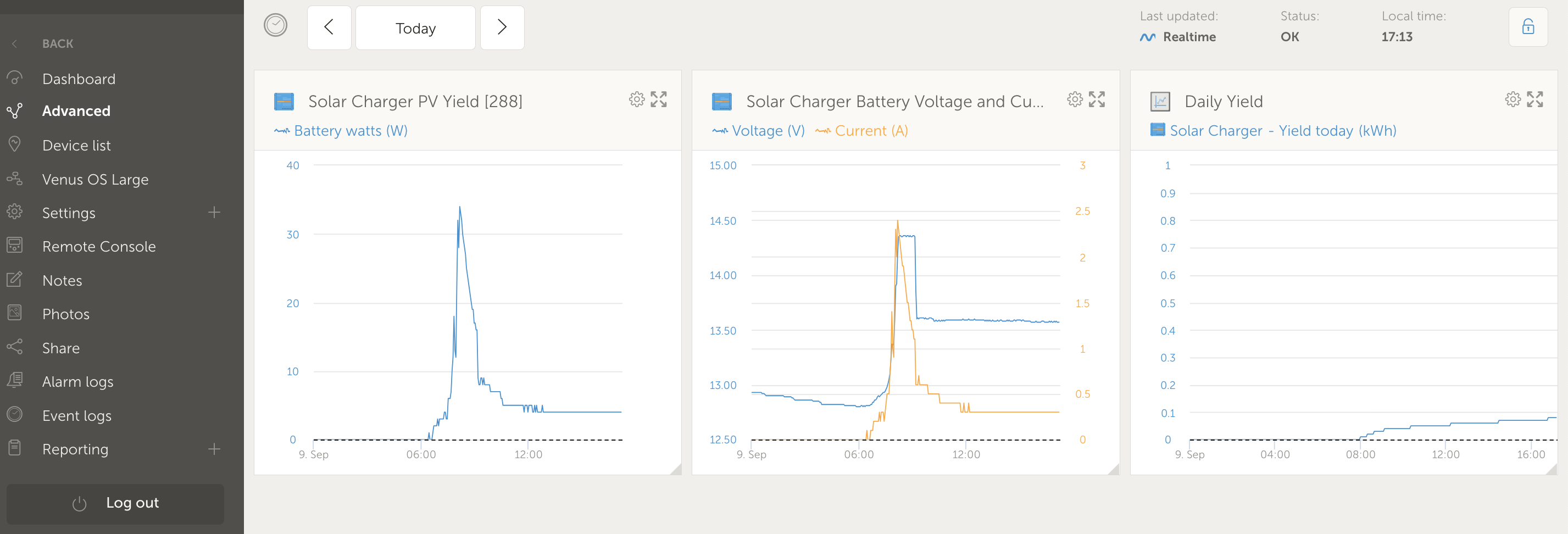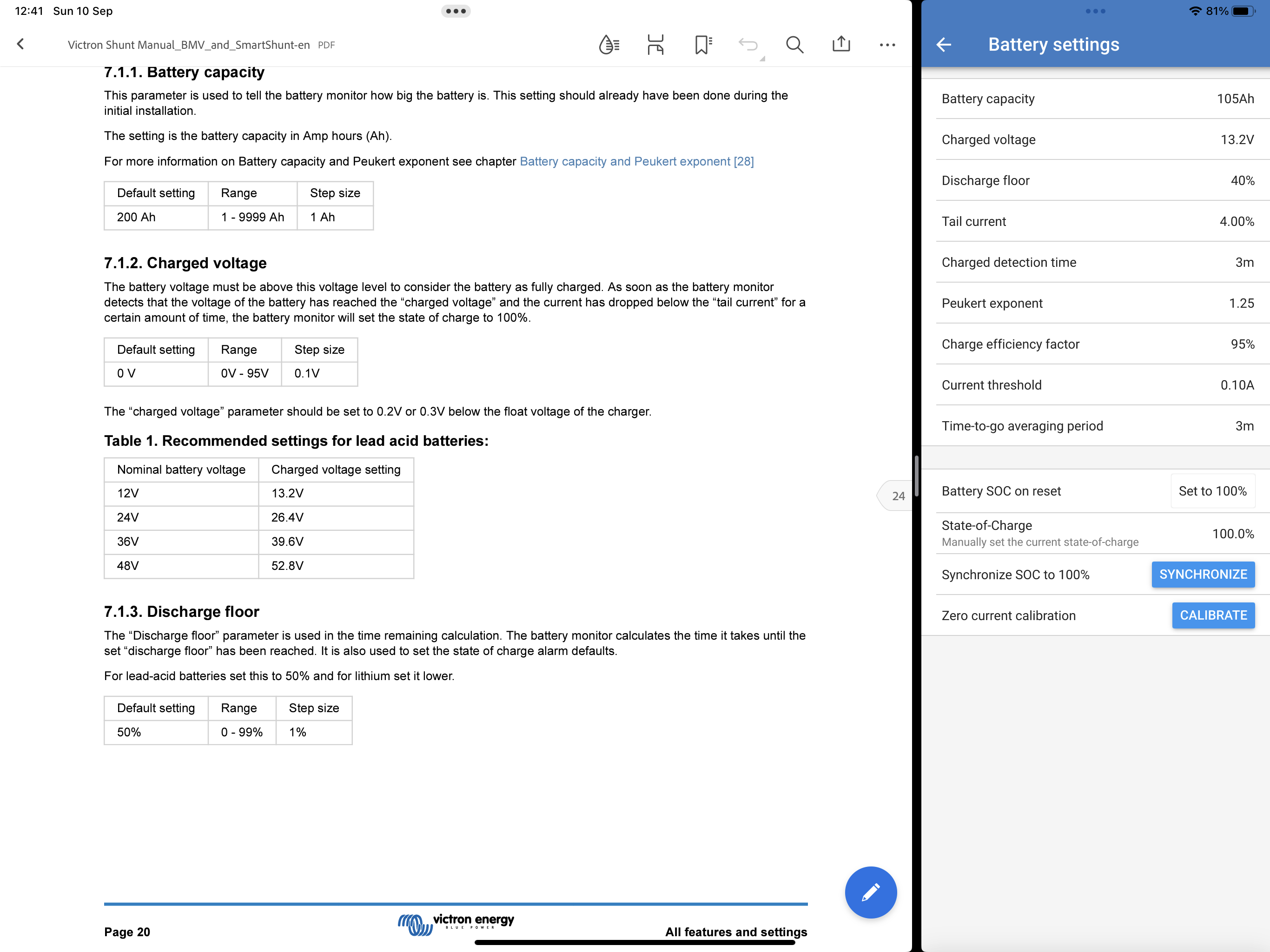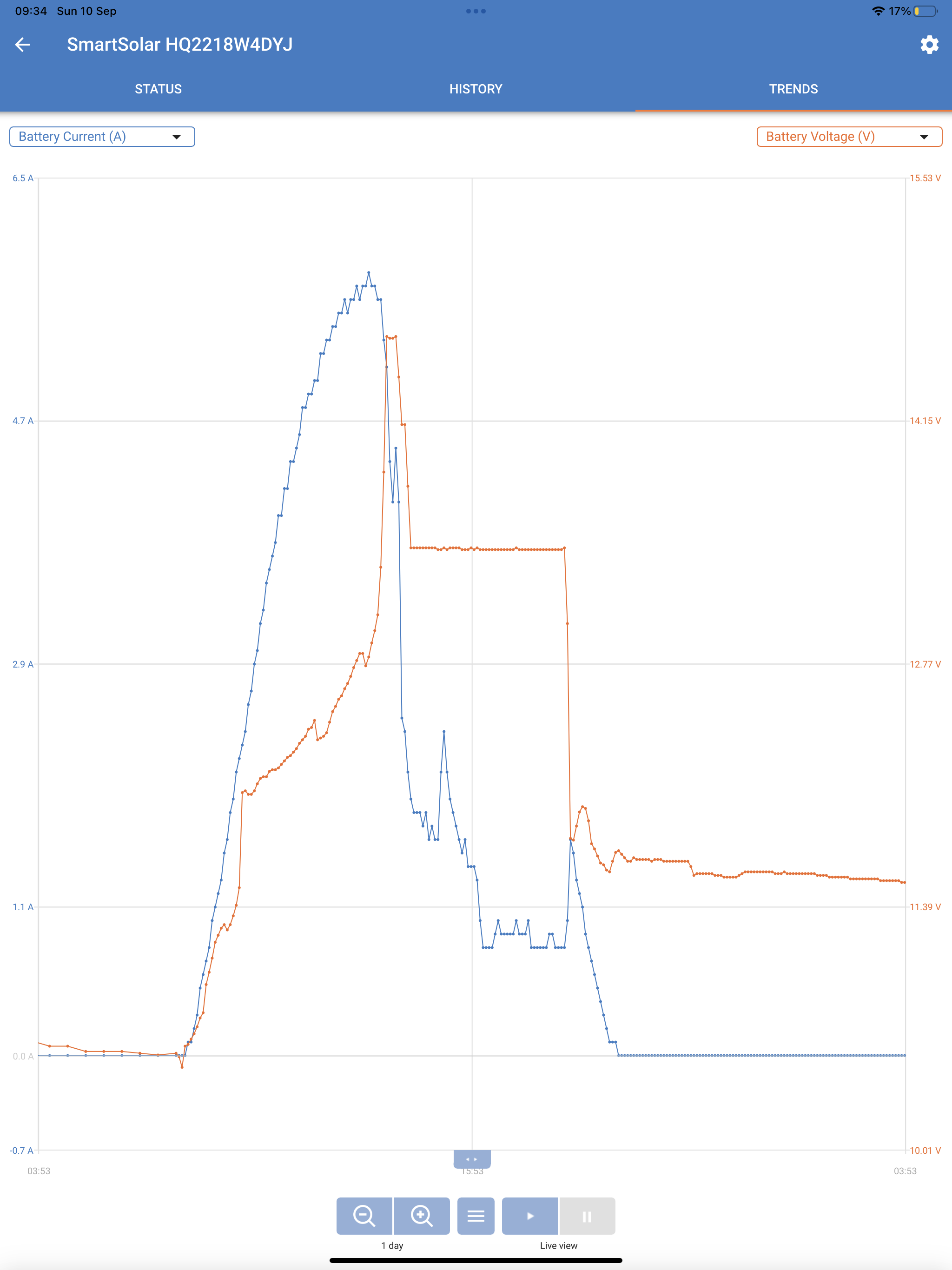I have a single solar panel (120W) and a single Varta Professional Dual Purpose AGM LA105 aH battery. Should i use a pre configuration setting on the Vicitron 75/15 MPPT controller or enter specific ones for the battery.
- Home
- Anonymous
- Sign in
- Create
- Spaces
- Grafana
- Node-Red
- Unsupported topics
- Questions & Answers
- Modifications
- Communauté francophone
- Deutschsprachiger Bereich
- Preguntas en Español
- Explore
- Topics
- Questions
- Ideas
- Articles
- Badges
question
The correct answer of course is to use the manufacturers recommended settings. However, sometimes they can be illusive and are often not stated in the published technical specifications. You may need to be tenacious and ask Varta directly for the information you require.
That being said..
Preset #1 or #2 (refered to as 'gel' in victron connect) is the generic preset available for regular AGM deep cycle batteries. Importantly Equalisation should be switched OFF (disabled). Max charge current limited below 20% of battery capacity (you will be fine with one 120W panel).
If it was me I would probably start with preset #1 and then modify it in expert mode to drop the Float voltage to 13.6V until I got more detailed instructions from the manufacturer. I would also use Adaptive absorption rather than fixed.
So i have made the changes you have suggested. It is a new 105ah battery. Fully charged at sunset. I have a Victron SmartShunt installed and i can see that for about 3 hours i am using about 1amp and then for 2 hours using 4amps at which point the battery is showing 10.6 volts on the onboard Nordelectrica panel and shuts down. Surely i have only used (3*1)+2*4 =11 ah. Or am i being completely stupid.
That is seriously undercharged!! You need to stop using that battery!. It clearly was not fully charged before you started....
I suggest it needs to go through a complete charging cycle before using it again to prevent damaging the battery. Did you have any solar charging today? What were you powering off the battery?
I installed this battery as a leisure battery for my motorhome before this trip and charge it off the mains for many hours. It shows as fully charged. I have had electric hook ups for most of the trip so it has been charged numerous times whilst driving always showing 100% when i stop. This is the first time on battery only and it lasted about 5 hours before showing fully discharged.
How can i put it through a complete charging cycle? This morning on the SmartShunt it showed 90% but 10.6v and after a day in the sun is showing 100% and 13.43v.
I am only running an LED light and charging a couple of phones/Ipads.
There are many variables here to pick through.
First 90% SOC at 10.6v sounds very suspect?? With NO loads on and rested, ie a few hours after charging, I would expect that battery to be around 12.8v fully charged. This makes me suspect that the SmartShunt is not synchronised with the state of charge (SOC).
If you have no way of doing a mains charge (with a 3 stage charger) then the only way to check what is happening is to go through a solar cycle and monitor on VRM exactly what is happening (you can go to the Advanced menu and set up a few graphs to monitor), like this:-
@Tattersp It's on the VRM https://vrm.victronenergy.com/login It allows remote monitoring, do you have internet where you are? Are you using a Smart solar MPPT 75/15?
Not to worry... you can also monitor on Victron connect to see Voltage/current charge and of course PV watts. You should be able to connect locally with blue tooth if you have a Smart Solar?
The point is you need to see what the charging cycle looks like and see if the solar charger is actually doing what it should be and then you can see how long the battery holds its charge for. If it doesnt settle at around 12.8v after 12 hours but keeps discharging then the battery may well be losing charge somewhere, or it is faulty?
Yes you should have charged it, no problem there. What charger did you use as a matter of interest?
I realised you don't have a GX device in your system so unfortunately you won't be able to use the VRM. Sorry if my reference, and graphs confused the issue, it is just a very useful tool for remote troubleshooting.
So, the MPPT is doing what it should do. The Voltage after the Float period then drops steeply to under 12V (11.7Vish..?) What happened there? What typically happens if you switch on a Big load then the voltage would drop, but I am talking about an inverter supplying a kettle or something, not LED lights. After the load is switched off you would expect the Voltage to recover towards the "rested" voltage... it doesn't ? So, are you sure there is no load that you are supplying that you hadn't planned?
Yea it does sound "nuts". What is also worrying is that when you stop charging the voltage does not recover (upwards) towards a more sensible range? Your discharge floor should be around 50% to be "safe" (AGM can go a little further but will shorten the life of the battery if regularly discharged below that). [In voltage terms 50%SOC equates very approximately to ~12.05V for a rested AGM, therefore any time you start your day with the battery below 12V you are at the discharge floor]
If at all possible can you disconnect "all" loads and then let the solar charge for the day, to see what voltage the battery falls back to overnight? I know it is a pain...
The thing is....If your battery has spent too much time at 10.6V it will cause damage over time. If there is any possibility of a load draining the battery down to 10.6V (not always with you knowing?) then you need to trace that leakage? If you are sure that it is just iPad charging and lights then I would try and send the battery back if it is under warranty. The sure sign of a duff battery is when it doesn't hold it's charge, particularly immediately after you have charged it!
It "may" be possible to revive the battery with multiple daily charges and NO loads (not much use to you...!), over a period of time but no guarantees? You may find each day the "rested" voltage gains a bit until the battery is back near to capacity?
I agree with you, looking at your quoted usage above a full battery in new condition should give you more usage than your figures above. A voltage of 10.5v is basically 0% SOC and could be indicative of a shorted cell..!! When not in use and not charging does the voltage recover at all??
I'll also add that after full charging is complete you'll need to let the battery 'rest' for 12 to 24 hours. At some point during that time you'll notice the battery voltage will drop then settle out at a constant voltage. That is the point where you determine the battery's full charge status or SOC. Conversely if the battery has had a load applied to it you'll notice the voltage will rise somewhat before settling out once again. In other words don't take voltage readings until the battery has had a chance to settle out and become steady.
Would be a good idea to check the shunt battery settings.
There's a video on YouTube by one of the Victron guys, Johannes Boonstra about settings for the shunt. Solar charging is affected by weather/clouds, season. These can cause false early synchronisation to 100%
For solar/AGM recommendation is to:
Increase the charged voltage setting from default. Mine's on 14.2V.
Increase charge detection time. Depends on local conditions. Mine's on 10 or 15 mins, can't get to the van to check.
Reduce tail current maybe. This one's trickier to tune. You are trying to find a setting between the current going into a fully charged battery at float voltage and charging current under poor lighting conditions. Experiment with detection time and voltage. Consider tail current later when you're confident the other two parameters are reasonably ok.
You'll need to experiment. The start synchronised setting is mostly for maintenance and can usually be left on/100%.
https://www.victronenergy.com/media/pg/SmartShunt/en/configuration.html
I would go through chapter 4 "Configuration" and also look at chapter 7 , particularly 7.2 "Battery settings" . Bearing in mind that if your battery really is 10.6V then SOC is 0% (do you have a multimeter to actually check voltage)
I have been through the sections you recommended and can see the only one out of norm for an AGM battery is the discharge floor set at 40% instead of 50%. Yes i do have a multimeter available.

The recommendation for charged voltage is 0.2V below float so could be changed to 13.4V (assuming float is 13.6V in MPPT?). I don't think this is the heart of your problem though.
EDIT: On reflection and in light of 10.3.11. "Synchronisation issues" it may be part of the problem....
The areas that need attention are Calibration (this involves confirming the zero load current) and Synchronisation. Bear in mind that Auto Synch assumes 100% SOC which you are nowhere near!! So you would have to do this in Manual (unless you can eventually get a full charge confirmed by rested voltage)
For Calibration look at 7.2.13. Zero current calibration.
For Synchronisation look at 7.2.10. Battery starts synchronised
In your case you cannot assume the battery was fully charged when you connected it... so, note from 7.2.10:-
"There are two ways of solving this, one is to not disconnect the battery monitor when the batteries are partially discharged or alternatively turn the “Battery starts synchronised” feature off. Now when the battery monitor is reconnected the state of charge will display “---” and will not show 100% until the batteries have been fully charged. Please note that leaving a lead acid battery ina partially discharged state for a length of time will cause battery damage."
Buried away at the end of the manual is this statement, which could be your problem!! It should in my opinion be stated back at 7.2.10
10.3.11. Synchronisation issues If the battery monitor does not synchronise automatically, one possibility could be that the battery never reaches a fully charged state. Fully charge the battery and see if the state of charge eventually indicates 100%.Another possibility is that the charged voltage setting [22] should be lowered and/or the tail current setting [23] should be increased.It is also possible that the battery monitor synchronises too early. This can happen in solar systems or in systems that have fluctuating charge currents. If this is the case change the following settings:• Increase the “charged voltage [22]" to slightly below the absorption charge voltage. For example: 14.2V in case of 14.4V absorption voltage (for a 12V battery).• Increase the “charged detection time [23]” and/or decrease the "tail current [23]" to prevent an early reset due to passing clouds.
Did you also do the Zero current Calibration and turn the “Battery starts synchronised” feature off. ?
If you disconnect power to the monitor and then reconnect the changes should take place and you will see "--" for SOC. Then during the next solar day when the charge conditions are met the SOC will (eventually) display 100%
That is I believe part of the problem. The other part is whether the battery is damaged (by discharge), time will tell if the voltage range and capacity return to normal?
It always dropped below 11v. The heaviest load item was the drop down bed motor. Just running that when it is fully charged drops the voltage immediately.
The golden rule for any Lead Acid battery (including AGM) is not to discharge it to nothing! When the battery is under "heavy" load you can expect to occasionally drop to below 12 V, but it should always recover when the load is removed..... The fact that your battery has been discharged to 10.6 V (probably more than once?) does not bode well... There are some Smart battery chargers that have a "recondition" type program but I wouldn't bother with that until you have had the battery tested. Sorry I can't be more positive..
Related Resources
Additional resources still need to be added for this topic
question details
42 People are following this question.

